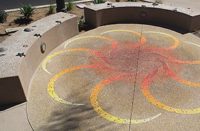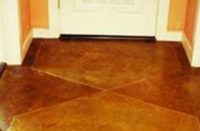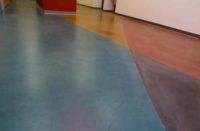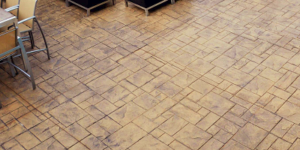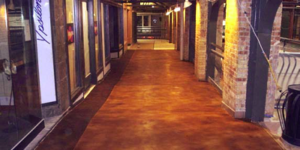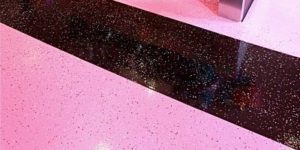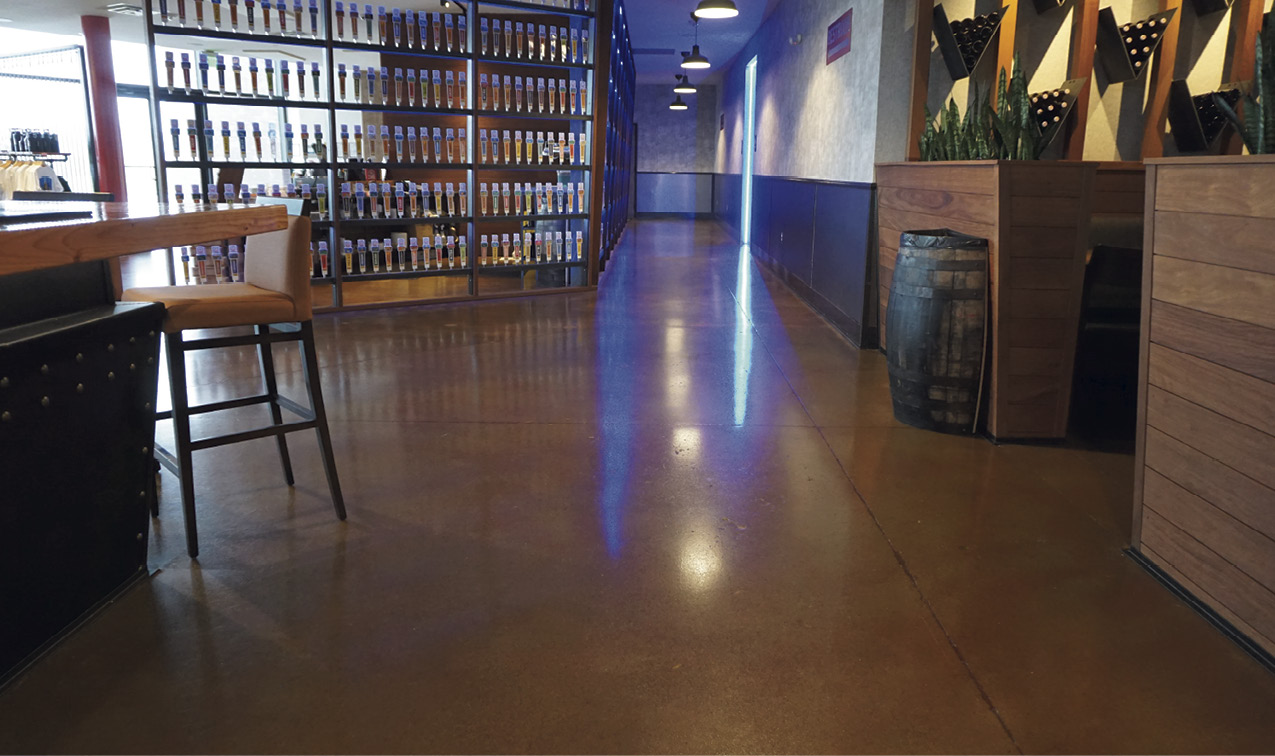
What’s the difference between concrete and decorative concrete? One of the first indicators is whether it has the dull gray color of … well, concrete, or if it incorporates a natural or even not-so-natural hue, tone or shade.
Of course, there are also several ways to add color to concrete. This is depending on the needs and desires of the client. One that continues to make a splash are water-based stains, based on their ease of application, range of colors and ability to work even on old concrete.
That’s not to say it’s time for contractors to turn their backs on acid-based stains, though. Not only do they represent a standard for many clients who want that traditional look, but suppliers who sell both say they aren’t seeing any real drop-off in acid-based stain numbers, even as their water-based competition continues to grow.
“What we’ve seen is almost an equalization of the technology based on the consumer’s commitment and preference of style,” says Jeff Wells, training and business development manager for H&C Concrete Stains in Cleveland. “There are a lot of architects, as well as consumers, who still like that more rustic look, that earthier look, or the less-manufactured look of acid stains.”
What’s the difference?
The difference between the two is as simple as the names imply: acid-based stains (also known as reactive or chem stains) use a small amount of hydrochloric acid and metallic salts for coloring. The two react with the calcium hydroxide in the concrete.
“Because of the reactive properties with lime/portland cement, acid stains are considered a permanent, color option for interior and exterior surfaces,” says David Barreto, business development manager with Epmar Corp., in Whittier, California. “Acid stains do not peel or fade under UV (ultra-violet) rays.”
Since the process uses metallic salts, the color palette for acid-based stains is limited and runs heavily to earth tones. The result is also often uneven, leaving a mottled, marble or stone appearance. The acid used in the process also must be neutralized prior to sealing or buffing.
However, Rich Cofoid, senior product manager for Increte Systems in Odessa, Florida, says acid-based stains that include copper ferrous in them tend to turn black when a lot of moisture is present.
By comparison, a water-based stain is a nonreactive process that involves water (or acetone) to which pigment and polymers are added to create the color.
“The water-based stains are straight color,” says Mark Hampston, chief executive officer of Redi-Mix Colors in Taunton, Massachusetts. “You’re going to get a straight color, plus the coverage is more uniform and predictable. You can also dilute them as you’re adding different coats to make some areas darker and some lighter.”
The color palette also goes well beyond what can be achieved with metallic salts.
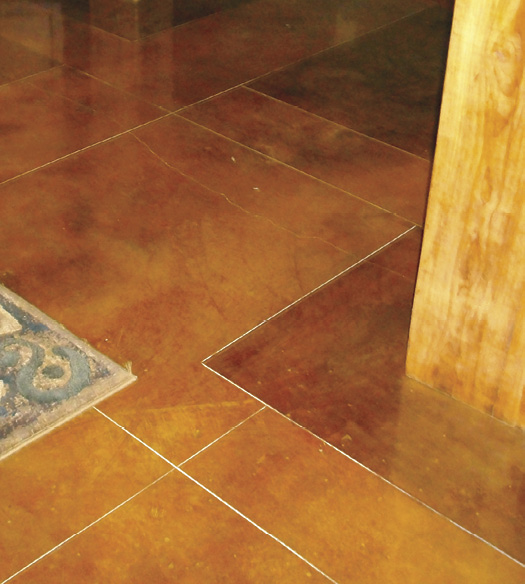
Dyes are an option
Although Clemons Concrete Coatings in Nashville, Tennessee, doesn’t offer a water-based stain, Tim Allen, the company’s technical director, says it does sell water-based dyes that are true solutions of dye molecules rather than finely ground pigments in suspension as is the case with water-based stains. The dyes are suitable for interior use.
However, in both water-based stains and dyes it’s the color palette that makes those products so attractive.
“Not only can you get a nice mottled appearance with the dyes, but it’s easy to apply with stencils, for example,” Allen says. “And, the color spectrum is large. You can get exotic hues that you might encounter with commercial jobs, such as purples, yellows and blues.”
Water is more workable
Water-based stains first came on the market early in the century, and H&C’s Wells says while people still want to accomplish the look that acid-based stains produce, they’ve been looking for an option that would give them that look with more reliability and less labor than the acid-based products.
There’s also a matter of flexibility.
“Once the acid stain hits the calcium hydroxide or the lime, it’s spent and the impression of color you get is a permanent solution,” says Wells. “With the semi-transparent water-based stains, if you overapply or have a mishap in your application, you can take regular tap water and diffuse the color very well.”
With one process using tap water and the other an acid base, it seems to suggest that the water-based formula is more environmentally friendly. However, suppliers of both products say that may or may not be so. And while a segment of contractors and their clients base their choice on products that are eco-friendly, others aren’t necessarily thinking about the environment when it comes time to stain their concrete.
For instance, even though the amount of acid in acid-based stains is low, it can kill vegetation if an outdoor application is oversprayed. However, the big issue is the metallic salts.
“Some of the metallic salts are a known marine hazard,” says Increte Systems’ Cofoid. “You don’t want the copper ferrous rinsed from a driveway into a storm drain or sewer.”
Acids can be temperamental
The bottom line on environmental issues is probably best summarized by Todd Rose, a sales manager and trainer for Springfield, Illinois-based Solomon Colors/Brickform, when he observes, “My customers base their choices mostly on color availability.”
Beyond color, there is one thing contractors should consider when weighing the advantage of a particular stain. And that is the concrete you are applying it on. Acid-based stains can be a bit temperamental both early and late in the game.
Cofoid notes that on new pours, manufacturers of acid stains urge users to wait a full 28 days, so the free lime can develop and there’s something to react with the stain. However, as the concrete ages, its chemical composition will change again.
“Over 100 years, there’s going to be very little of that chemical left in the concrete. This can have an impact on how dark or deep your colors become,” he says.
Solomon Colors’ Rose stresses that it’s always a good idea to do a test area. He recommends doing this on every job to help eliminate those surprises. He also says he never does an acid-based stain job without having the corresponding water-based stain on hand, as well.
“If something happens to the slab — say the plumber has dropped some of the threading liquid they use on pipes — it’s very difficult to get an acid stain to react with it,” Rose says. “By having a corresponding water-based stain on hand, you can still stain the concrete.”
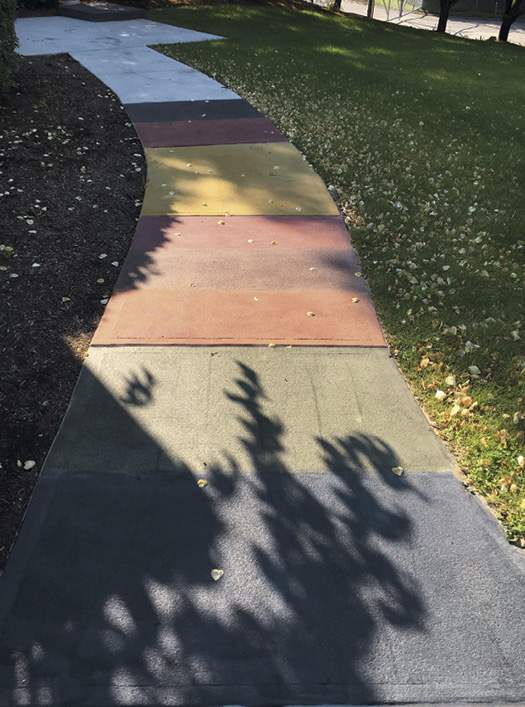
The two work well together
Using the two together can also create some nice effects, say both Clemons’ Allen and H&C’s Wells.
“Maybe they want a color that can best be achieved by the application of two different colors,” says Allen. “Sometimes it’s done as a color correction after the acid stain application, or maybe the homeowner wants it just a bit more toward this color or that color that you can’t get with acid stains.”
Wells agrees and says the result is often a more-dimensional look than what’s achievable using either stain by itself. He also believes that’s a trend that will continue.
“We’re starting to see some accelerated growth where other hard-surface applications have been done,” he says. “We’re really starting to see growth in semi-transparent applications for restaurants, community and commercial facilities. If anything, contractors will get more creative with what they can do and how they’re able to enhance color and create 3-D effects.”
Improvements on the horizon
Both Rose and Cofoid say they expect the use of water-based stains to continue increasing. Cofoid also predicts improvements in the coating end — epoxies, two-part polyureas and polyaspartics — for still more durability.
Allen sees the water-based stains improving their pigments, as well.
“The pigment industry will be able to obtain finer and finer particle sizes for producing the pigments,” Allen says. “The end goal is to make the particles small enough where they get into the concrete.”
Redi-Mix’s Hampston agrees that water-based stain technology will continue to improve. While the improvements haven’t hit the big-box stores yet, its ease of use will mean concrete professionals will have a wider market for application.
“Concrete is a very interesting product. There are no two pieces of concrete that are ever alike because of climate and the materials within the concrete,” he concludes. “It’s an ever-changing platform, and cleanliness is most critical. This is a job that should stay in the hands of professionals.”
www.ccc-usa.com
www.hcconcrete.com
www.increte.com
www.redimixcolors.com
www.solomoncolors.com
Looking for Acid or Water-based Stains?
Offered by Concrete Decor Store Hydro-Stain 1500 Concrete Stain - 1 Quart
Hydro-Stain 1500 Concrete Stain - 1 Quart
by Redi-Mix Colors Concrete Acid Stain - Vivid Stain (Formerly SureStain) - 1 Gallon
Concrete Acid Stain - Vivid Stain (Formerly SureStain) - 1 Gallon
by SureCrete
